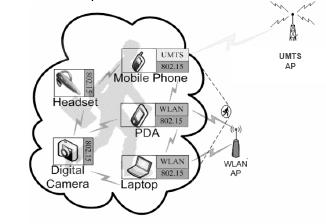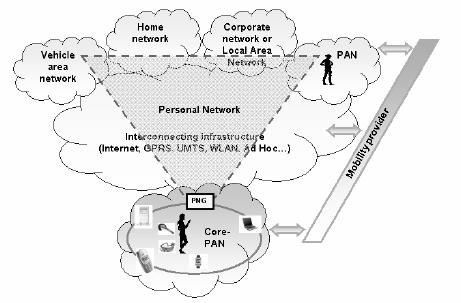Difference between revisions of "Egon Gleisberg"
| (13 intermediate revisions by the same user not shown) | |||
| Line 1: | Line 1: | ||
== | ==Learning Log== | ||
* [[Personal Reflection Egon Gleisberg]]<br> | |||
* [[Professional Reflection Egon Gleisberg]]<br> | |||
* [[Academic Reflection Egon Gleisberg]]<br> | |||
[[Image:WPAN.JPG]] | ==Product of the Future: Personal Network== | ||
[[Image:PersonalNetwork.JPG]] | <table align="center"><tr><td> | ||
[[Image:WPAN.JPG]]</td><td> | |||
[[Image:PersonalNetwork.JPG]]</td></tr> | |||
<tr><td valign="center"><i>Personal Area Network [1]</i></td><td valign="center"><i>Personal Network [1]</i></td></tr></table> | |||
<br> | |||
===Personal Area network (PAN)=== | |||
A PAN can be defined as a network of devices in the personal operating | |||
space of the user. The user is carrying a laptop, a PDA, a mobile phone, a wireless headset and a digital camera. The | |||
devices are networked with each other by means of high-data-rate WPAN technology. The mobile phone, the laptop and the PDA | |||
can also communicate to the rest of the world by means of Universal Mobile | |||
Telecommunications System (UMTS) technology or Wireless Local Area Network | |||
(WLAN) technology. This configuration enables e.g. pictures taken by the digital | |||
camera to be emailed by means of the email client on the PDA and the UMTS | |||
connection of the mobile phone.[2]<br> | |||
<br> | |||
===Personal Network (PN)=== | |||
A Personal Network is envisaged as the next step in achieving unlimited communication between peoples electronic devices. A PN provides the technology needed to interconnect the various private networks of a single user seamlessly, at any time and at any place. Such private networks are home networks, car networks, company networks, PANs, and others. Often, a user wants to remotely access content, applications, or resources that are located in one of his private domains.[1] | |||
<br><br> | |||
Example: A business man who is at a conference wants to take pictures of the various demonstrators without having to worry where the pictures should be stored: on the memory card of the camera, the hard disc of the laptop, the content server in the office, or the desktop computer at home. A PN should solve the current limitations that inhibit (user-friendly) access. | |||
===New=== | |||
Personal Area Network is already a term that most people are familiar with. One step further, the combination of different PANs results in a Personal Network. This network combines all thinkable small (private) networks with different protocols to communicate with voice, data or video. People can share this information from different devices, between different networks at all time. | |||
===Replace=== | |||
what other objects does this object replace? | |||
With this network we can replace, for example, an USB-stick that operates as temporary storage device. Because of sharing techniques this devices can communicate without interruptance of e.g. an USB-stick. | |||
===Change=== | |||
Sharing data between devices or networks can be done quicker and more efficient. At any place and at any time people can access their devices. | |||
<br> | <br> | ||
References:<br> | References:<br> | ||
[http://www.tno.nl/bestanden/informatie-_en_communicatietechnologie/pnp2008whitepaper.pdf PNP2008 TNO] | [1][http://www.tno.nl/bestanden/informatie-_en_communicatietechnologie/pnp2008whitepaper.pdf PNP2008 TNO]<br> | ||
[http://en.wikipedia.org/wiki/Wireless_personal_area_network Wikipedia Personal Area Network] | [2][http://en.wikipedia.org/wiki/Wireless_personal_area_network Wikipedia Personal Area Network]<br> | ||
[http://www.freeband.nl/uploadedFiles/FreeNovation/Magazine_Nr2/Articles/Article_1123_nl.pdf Freebank Personal Network] | [3][http://www.freeband.nl/uploadedFiles/FreeNovation/Magazine_Nr2/Articles/Article_1123_nl.pdf Freebank Personal Network (Dutch)]<br> | ||
Latest revision as of 10:00, 4 May 2007
Learning Log
- Personal Reflection Egon Gleisberg
- Professional Reflection Egon Gleisberg
- Academic Reflection Egon Gleisberg
Product of the Future: Personal Network
 |
 |
| Personal Area Network [1] | Personal Network [1] |
Personal Area network (PAN)
A PAN can be defined as a network of devices in the personal operating
space of the user. The user is carrying a laptop, a PDA, a mobile phone, a wireless headset and a digital camera. The
devices are networked with each other by means of high-data-rate WPAN technology. The mobile phone, the laptop and the PDA
can also communicate to the rest of the world by means of Universal Mobile
Telecommunications System (UMTS) technology or Wireless Local Area Network
(WLAN) technology. This configuration enables e.g. pictures taken by the digital
camera to be emailed by means of the email client on the PDA and the UMTS
connection of the mobile phone.[2]
Personal Network (PN)
A Personal Network is envisaged as the next step in achieving unlimited communication between peoples electronic devices. A PN provides the technology needed to interconnect the various private networks of a single user seamlessly, at any time and at any place. Such private networks are home networks, car networks, company networks, PANs, and others. Often, a user wants to remotely access content, applications, or resources that are located in one of his private domains.[1]
Example: A business man who is at a conference wants to take pictures of the various demonstrators without having to worry where the pictures should be stored: on the memory card of the camera, the hard disc of the laptop, the content server in the office, or the desktop computer at home. A PN should solve the current limitations that inhibit (user-friendly) access.
New
Personal Area Network is already a term that most people are familiar with. One step further, the combination of different PANs results in a Personal Network. This network combines all thinkable small (private) networks with different protocols to communicate with voice, data or video. People can share this information from different devices, between different networks at all time.
Replace
what other objects does this object replace? With this network we can replace, for example, an USB-stick that operates as temporary storage device. Because of sharing techniques this devices can communicate without interruptance of e.g. an USB-stick.
Change
Sharing data between devices or networks can be done quicker and more efficient. At any place and at any time people can access their devices.
References:
[1]PNP2008 TNO
[2]Wikipedia Personal Area Network
[3]Freebank Personal Network (Dutch)